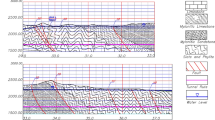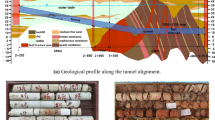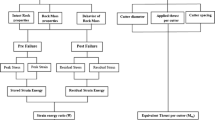Abstract
EPB TBMs (Earth pressure balance Tunneling Boring Machines) are extensively used in tunneling constructions because of its high efficiency and low disturbance on structures above ground. It is critically significant to predict the thrust acting on TBMs under different geological conditions for both the design of power system and the control of tunneling process. The interaction between the cutterhead and the ground is the core of excavation, through which geological conditions determine the thrust re-quirement combined with operating status and structural characteristics. This paper conducted a mechanical decoupling analysis to obtain a basic expression of the cutterhead-ground interactive stress. Then more engineering factors (such as cutterhead topological structure, underground overburden, thrusts on other parts, etc.) were further considered to establish a predicting model for the total thrust acting on a machine during tunneling. Combined with three subway projects under different geological conditions in China, the model was verified and used to analyze how geological, operating and structural parameters influence the acting thrust.
Similar content being viewed by others
References
Zhao Y, Wang H, Yu H D, et al. A stiffness-matching based evaluation approach for compliance of mechanical systems in shield tunneling machines. Sci China Tech Sci, 2012, 55: 2926–2935
Krause T. Schildvortrieb mit flüssigkeits-und erdgestützter Ortsbrust. Mitteilung des Instituts für Grundbau und Bodenmechanik. (in German). Braunschweig: TU Braunschweig, 1987
Shi H, Gong G F, Yang H Y, et al. Determination of thrust force for shield tunneling machine (in Chinese). J Zhejiang Univ (Eng Sci), 2011, 45: 126–131
Maidl B, Herrenknecht M, Anheuser L. Mechanised Shield Tunneling. Berlin: Ernst & Sohn, 1996
Gertsch R, Gertsch L, Rostami J. Disc cutting tests in Colorado Red Granite: Implications for TBM performance prediction. Int J Rock Mech Min, 2007, 44: 238–246
Yin L J, Gong Q M, Zhao J. Study on rock mass boreability by TBM penetration test under different in situ stress conditions. Tunn Undergr Sp Tech, 2014, 43: 413–425
Cho J W, Jeon S, Jeong H Y, et al. Evaluation of cutting efficiency during TBM disc cutter excavation within a Korean granitic rock using linear-cutting-machine testing and photogrammetric measurement. Tunn Undergr Sp Tech, 2013, 35: 37–54
Jakobsen P D, Langmaack L, Dahl F, et al. Development of the Soft Ground Abrasion Tester (SGAT) to predict TBM tool wear, torque and thrust. Tunn Undergr Sp Tech, 2013, 38: 398–408
Su C X, Wang Y Q, Zhao H F, et al. Analysis of mechanical properties of two typical kinds of cutterheads of shield machine. Adv Sci Lett, 2011, 4: 2049–2053
Kasper T, Meschke G, A 3D finite element simulation model for TBM tunnelling in soft ground, Int J Numer Anal Met, 2004, 28: 1441–1460
Hasanpour R, Rostami J, Ünver B. 3D finite difference model for simulation of double shield TBM tunneling in squeezing grounds. Tunn Undergr Sp Tech, 2014, 40: 109–126
Sun W, Ling J X, Huo J Z, et al. Dynamic characteristics study with multidegree-of-freedom coupling in TBM cutterhead system based on complex factors. Math Probl Eng, 2013, 2013: 1–17
Huo J Z, Wu H Y, Yang J, et al. Multi-directional coupling dynamic characteristics analysis of TBM cutterhead system based on tunnelling field test. J Mech Sci Technol, 2015, 29: 3043–3058
Torabi S R, Shirazi H, Hajali H, et al. Study of the influence of geotechnical parameters on the TBM performance in Tehran-Shomal highway project using ANN and SPSS. Arab J Geosci, 2013, 6: 1215–1227
Mahdevari S, Shahriar K, Yagiz S, et al. A support vector regression model for predicting tunnel boring machine penetration rates. Int J Rock Mech Min, 2014, 72: 214–229
Ates U, Bilgin N, Copur H. Estimating torque, thrust and other design parameters of different type TBMs with some criticism to TBMs used in Turkish tunneling projects. Tunn Undergr Sp Tech, 2014, 40: 46–63
Copur H, Aydin H, Bilgin N, et al. Predicting performance of EPB TBMs by using a stochastic model implemented into a deterministic model. Tunn Undergr Sp Tech, 2014, 42: 1–14
Zhang Q, Kang Y L, Zheng Z, et al. Inverse analysis and modeling for tunneling thrust on shield machine. Math Probl Eng, 2013, 2013: 1–7
Zhang Q, Huang T, Huang G Y, et al. Theoretical model for loads prediction on shield tunneling machine with consideration of soilrock interbedded ground. Sci China Tech Sci, 2013, 56: 2259–2267
Festa D, Broere W, Bosch J W. Tunnel-boring in soft soil: A study on the driving forces applied to a slurry-shield TBM. In: Tunneling and underground space for a global society (WTC2012), Bangkok, Thailand, 2012
Sugimoto M, Sramoon A. Theoretical model of shield behavior during excavation. I: Theory. J Geotech Geoenviron, 2002, 128: 138–155
Wang L T, Gong G F, Shi H, et al. A new calculation model of cutterhead torque and investigation of its influencing factors. Sci China Tech Sci, 2012, 55: 1581–1588
Shangguan Z C, Li S J, Luan M T. Determining optimal thrust force of EPB shield machine by analytical solution, Electron J Geotech Eng, 2009, 14: 1–9
Wang L H, Kang Y L, Cai Z X, et al. The energy method to predict disc cutter wear extent for hard rock TBMs. Tunn Undergr Sp Tech, 2012, 28: 183–191
Rostami J. Study of pressure distribution within the crushed zone in the contact area between rock and disc cutters. Int J Rock Mech Min, 2013, 57: 172–186
Zhang Q, Hou Z D, Huang G Y, et al. Mechanical characterization of the load distribution on the cutterhead–ground interface of shield tunneling machines. Tunn Undergr Sp Tech, 2015, 47: 106–113
Wang L H, Kang Y L, Zhao X J, et al. Disc cutter wear prediction for a hard rock TBM cutterhead based on energy analysis. Tunn Undergr Sp Tech, 2015, 50: 324–333
Chen K, Hong K R, Wu X S. Shield Construction Technique (in Chinese). Beijing: China Communications Press, 2009
Johnson K L. Contact Mechanics. Cambridge: Cambridge University Press, 1985
Author information
Authors and Affiliations
Corresponding author
Rights and permissions
About this article
Cite this article
Zhang, Q., Su, C., Qin, Q. et al. Modeling and prediction for the thrust on EPB TBMs under different geological conditions by considering mechanical decoupling. Sci. China Technol. Sci. 59, 1428–1434 (2016). https://doi.org/10.1007/s11431-016-6096-0
Received:
Accepted:
Published:
Issue Date:
DOI: https://doi.org/10.1007/s11431-016-6096-0




